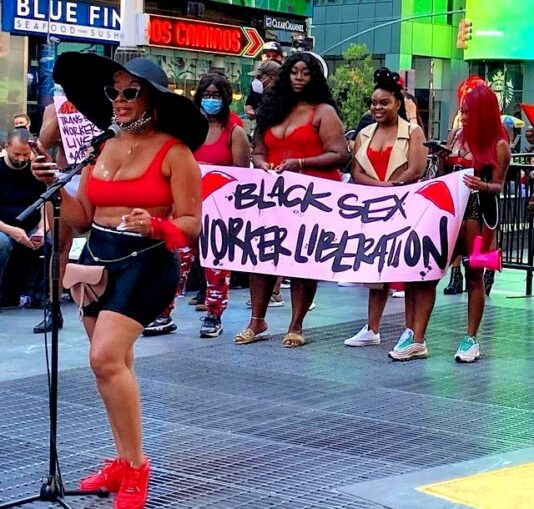

Sex work is a spectrum, a spectrum consisting of work such as erotic dancing, nude modeling, pornography, web camera modeling, sugaring (also called sugar dating, where money or material items are exchanged for sex and/or companionship) and full service street or escort work.


Black Sex Worker Liberation March, New York City, Aug. 8, 2020
There is another spectrum running across this spectrum: the spectrum of legal to illegal work. The rationale behind sex work criminalization can be varied. Sometimes it’s simple bourgeois or religious morality: Sex work is bad because it’s sinful! That can easily be dismissed as crankery. But the other argument for criminalization is more complicated: the need to end sex trafficking and the view that criminalizing sex work, regardless of the choice involved, is the way to do that.
Nobody wants sex trafficking to end more than sex workers. To eliminate sex trafficking, like eliminating drug trafficking, would be wonderful. But the problem is that doing so without the input of the most impacted in the U.S. — drug users, queer and trans people and poor people — only railroads them into more dangerous work.
Anyone who has done full service non-street work knows the necessity of being able to do background “research” on their clientele. What keeps these sex workers safe is the ability to screen clients: find out who they are, if they’re safe or if they appear on bad date lists, or if they have committed crimes against women, queer people or sex workers in general. Without screening, the workers would be walking into a situation with their eyes covered. They would have no idea how to determine if they can do their work and survive.
One of the demands for the liberation of sex workers is very simple: complete decriminalization of sex work. The ability of sex workers to function as sex workers with the ability to screen their clients would decrease the risk of sex workers being trafficked.
Much like with drug decriminalization, nothing — short of a socialist revolution — can eliminate trafficking 100%, but the situation would be better than it is now.
Problems with the “Nordic model”
With people realizing that pure criminalization — putting both sex workers and their clients in jails or prison — is not going to solve sex trafficking or help non-trafficked sex workers, there is a trend toward what is called the Nordic Model (also called the anti-equity model by sex worker activists). The Nordic Model, in a nutshell, makes it illegal to pay a sex worker for providing sexual services. In the eyes of its supporters, criminalizing clients would end sex work and therefore sex trafficking.
It would not. It pushes the safer clients (whose only “crime” would be hiring a sex worker) away from sex work while keeping people who do not respect sex workers and who have a higher likelihood of committing crimes against sex workers in the “client pool.” Instead of “reducing demand,” this approach increases harm. It would make trafficking far worse.
The proponents of the Nordic Model say that it helps full service sex workers (whose very humanity they ignore) “escape” the business. It does not. Even if it were true that every sex worker wanted to leave their job, the money spent pursuing and prosecuting clients of sex workers would be money not going to funding education or job training. Nordic Model advocates do not care about the wellbeing of sex workers. They don’t even view them as having the agency to do what they want or what they have to.
In countries that have adopted the Nordic Model, including Sweden where it was enacted in 1999, sex workers can lose their homes and be put on the street. This policy was borrowed from former criminalization models. For instance, in Pennsylvania, landlords or others who share living spaces with full service sex workers can be punished as “pimps” if they knew that their roommate or their renter did full service sex work.
Anti-sex trafficking organizations, such as Freedom Network USA, have acknowledged that every arrest of a sex worker or client means that aid to the truly trafficked is taken away. It costs money to fund anti-sex work campaigns that could go to helping people escape trafficking or even helping people stop engaging in subsistence sex work.
Sex workers and former sex workers cannot fight the Nordic anti-equity model alone. We need the support of the working class and the socialist movement. The fight for sex work justice is tied to the fight against misogyny, queerphobia and class exploitation. We need the world to understand that the most oppressed of our class need solidarity — and that building solidarity with us helps them.
The epic struggle of the Palestinian people against the full weight of U.S. imperialism and…
The following report comes from the Bronx Anti-War Coalition organizers on a protest held in…
In the Canadian federal elections held on April 28, the Liberals won with 169 seats…
The following is Part 2 of a talk given by the author to a meeting…
Boston Students, professors and workers are confronting the Trump administration’s fascist crackdown at universities across…
Philadelphia Within days of Swarthmore students reviving a pro-Palestinian encampment on April 30, police arrested…